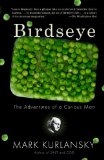Summary | Excerpt | Reviews | Beyond the Book | Readalikes | Genres & Themes | Author Bio

Critics' Opinion:
Readers' Opinion:
First Published:
May 2012, 272 pages
Paperback:
Feb 2013, 272 pages
 Book Reviewed by:
Book Reviewed by:
Jo Perry
Buy This Book
Chapter 1
A Nineteenth-Century Man
Clarence Frank Birdseye II was born in Brooklyn on December 9, 1886. Both the year and the place are significant. In 1886, Brooklyn was a separate city from Manhattan and, in fact, was the third-largest city in America and one of the fastest growing. Between 1880 and 1890 the population grew by more than a third to 806,343 people.
One of the forces that made this dramatic growth possible in Brooklyn and neighboring Manhattan was refrigeration. Because of this new technology a large population could live in an area that produced no food but rather brought it in and stored it. Natural ice, collected in large blocks from the frozen lakes of New England and upstate New York, was stored in sawdust-insulated icehouses built along the Hudson that shipped all year long. New York City used more than one million tons of natural ice every year for food and drink. While the pleasure of iced drinks in the summer had been a luxury of the wealthy ever since Roman times, in New York at the time of Birdseye's birth it had become commonplace. Almost half of all New Yorkers, Manhattanites and Brooklynites, kept food in their homes in iceboxes - insulated boxes chilled by blocks of natural ice. A few even had artificially chilled refrigerators, dangerous, clumsy electric machines with unpredictable motors and leaking fluids.
No place else in the world was using this much ice. Birdseye was born into a world of refrigeration and would find it lacking when he left the New York City area. It was one of those things that New Yorkers took for granted.
People are mostly formed over their first dozen years; Birdseye, having been born in 1886, was a nineteenth-century man, even though he lived most of his life in the twentieth century. This, of course, was not unusual. For the first half of the twentieth century, people shaped in the nineteenth century dominated most fields. John Kennedy, elected in 1960, was the first twentieth-century U.S. president. Historians have often commented on how historical centuries do not fit neatly between year 1 and year 99, and quite a few have thought the historical nineteenth century to be an unusually long one, lingering well into the twentieth, whereas the twentieth century to some appears to have been a short one, transitioning even before the year 2000 into a new age that would be associated with the twenty-first century.
Clearly, Birdseye was shaped by the nineteenth century. Even as an inventor, he used nineteenth-century industrial technology for nineteenth-century goals, as opposed to someone like his fellow Gloucester inventor John Hays Hammond, who harnessed radio impulses into such devices as remote control and was very much a twentieth-century inventor. Birdseye's inventions, from freezers to lightbulbs, were all mechanical and never electronic. Yet his impact on how people lived in the twentieth century was enormous.
The nineteenth century, the time of the Industrial Revolution, was an age of inventions, and inventors were iconic heroes. Ten years before Birdseye's birth, Alexander Graham Bell had invented the telephone. The following year Thomas Edison invented the phonograph. The year after that, 1878, Sir Joseph Wilson Swan, a British inventor, patented the first incandescent lightbulb and lit his house with it. The year before Birdseye was born, a German engineer named Karl Benz patented the first automobile that was practical to use, a three-wheeled vehicle powered by an internal combustion engine and fueled by periodically filling a tank with gasoline. The same year another German, Gottlieb Daimler, built the first gas-powered motorcycle. In 1886, the year of Birdseye's birth, Daimler built the first four-wheeled automobile.
Among the important inventors at the time of his birth, George Eastman was to have a profound effect on Birdseye. In 1884 he patented roll film, and in 1888 he produced a lightweight camera using that roll film, the Kodak camera. He and his company, the Eastman Kodak Company, the first major supplier of photographic equipment, gave birth to amateur photography, a passion of the young Clarence Birdseye. His was the first generation to grow up with amateur photography, and he was a pioneer - from his snapshots in the early twentieth century to home movies in the 1920s to color film in the 1930s.
Excerpted from Birdseye by Mark Kurlansky. Copyright © 2012 by Mark Kurlansky. Excerpted by permission of Doubleday, a division of Random House, Inc. All rights reserved. No part of this excerpt may be reproduced or reprinted without permission in writing from the publisher





The Flower Sisters
by Michelle Collins Anderson
From the new Fannie Flagg of the Ozarks, a richly-woven story of family, forgiveness, and reinvention.

The House on Biscayne Bay
by Chanel Cleeton
As death stalks a gothic mansion in Miami, the lives of two women intertwine as the past and present collide.

The Funeral Cryer by Wenyan Lu
Debut novelist Wenyan Lu brings us this witty yet profound story about one woman's midlife reawakening in contemporary rural China.
Your guide toexceptional books
BookBrowse seeks out and recommends the best in contemporary fiction and nonfiction—books that not only engage and entertain but also deepen our understanding of ourselves and the world around us.